Creating Fry Word Stacks is my favorite intervention for sight word mastery in the classroom.
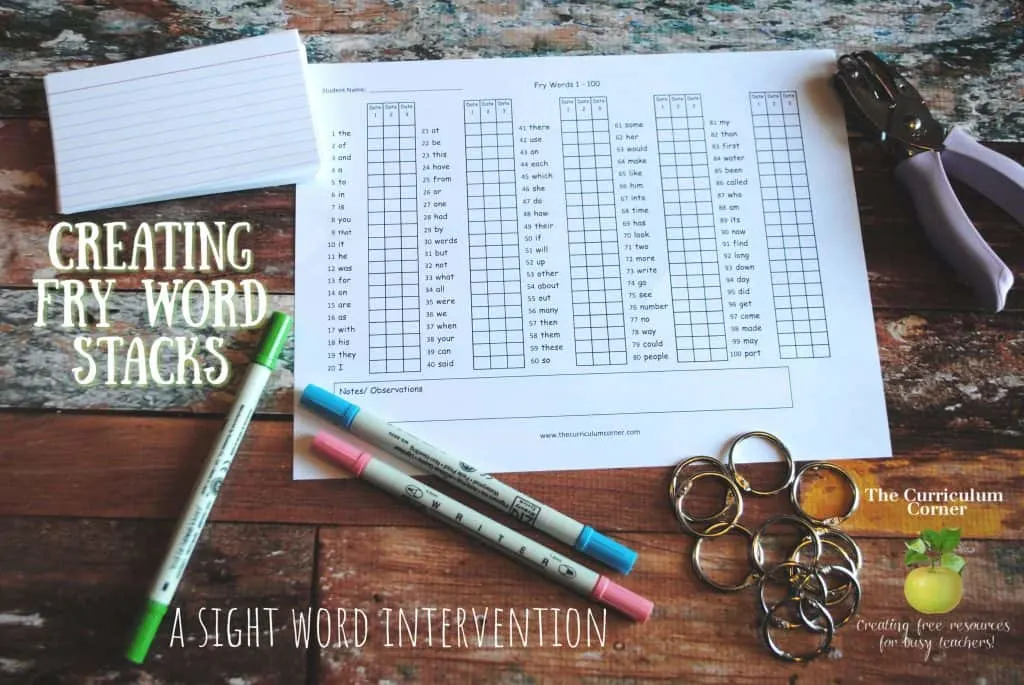
This is another free resource for teachers from The Curriculum Corner.
Why this strategy for sight word mastery?
If you are wondering how to teach Fry or sight word mastery in your classroom, this is my favorite strategy!
I like it because it is simple and effective. While we have geared this post specifically towards Fry words, you can use it to help with any sight word mastery.
I was introduced to the concept of Fry Word Stacks my first year teaching second grade and it has become my favorite strategy.
It started when I had one student who spoke very little in the classroom and could read even less. He was born in America. His dad spoke only Spanish and his mom spoke mostly English. He communicated very little with both the Spanish speaking and English speaking students in my class.
He was a challenge because it was not just about reading. I worked with another teacher and we stumbled upon a strategy that seemed too simple to be helpful. Still, we tried it and were rewarded with success.
Ready to work on Fry or sight word mastery?
Here are more details about this strategy:
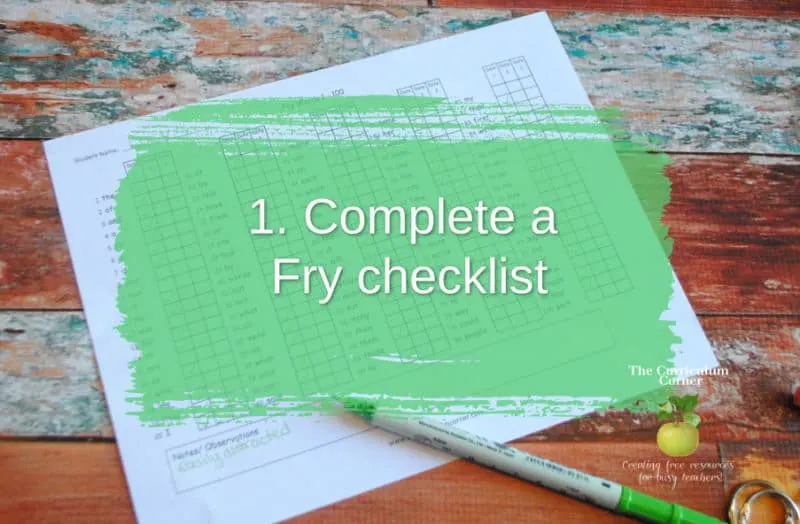
1. Complete a Fry checklist with your student.
You most likely will start by assessing the first Fry list (words 1-100). I typically sit 1-on-1 with a student. Then, record the date and have the student begin reading. I like to put a check on known words. You can leave the box blank for unknown words. Do what works for you!
Normally I like to have students complete the entire first word list in one setting so that I have a starting score out of 100 words. However, I don’t want to make my students frustrated! If a student is reading the first column of words and getting all or most wrong, I do not see a reason to have students go on. My job is to build student confidence, making students attempt to read 100 words they do not know does the opposite.
(Need a free copy of our checklists? You will find them here: Fry Word Checklists.)
***If you aren’t working specifically on Fry words, you can use your own sight word mastery list instead.
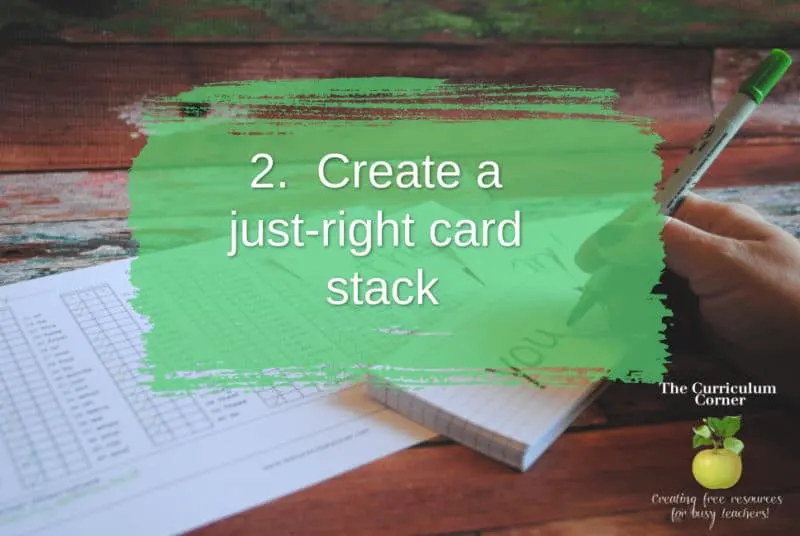
2. Create a just-right card stack.
This stack of cards should have about ten to twelve cards. I have always been told that research supports creating a stack of words that has three known words, one unknown word, three known words, etc. I mark the known words by putting a dot in the upper right corner.
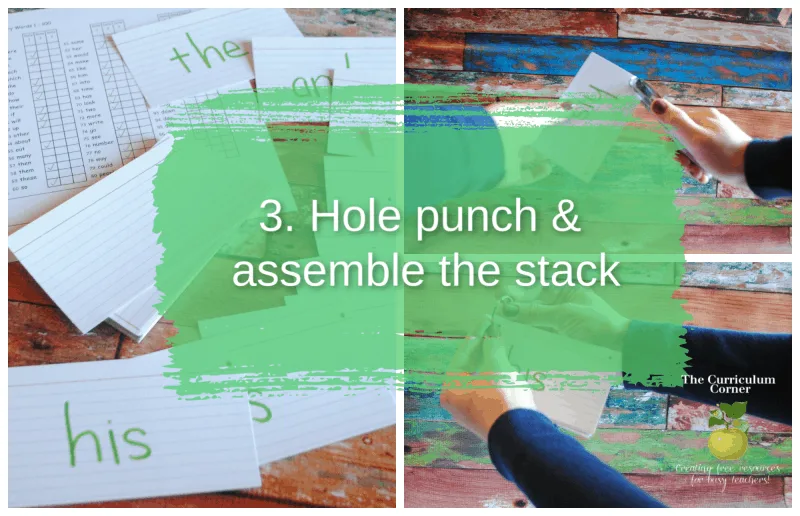
3. Hole punch and assemble the stack.
I find it helpful to hole-punch the cards and put them on a ring. This prevents a student from dropping his or her cards and getting them out of order. If you choose not to use rings, I find a baggie useful for storing the cards.
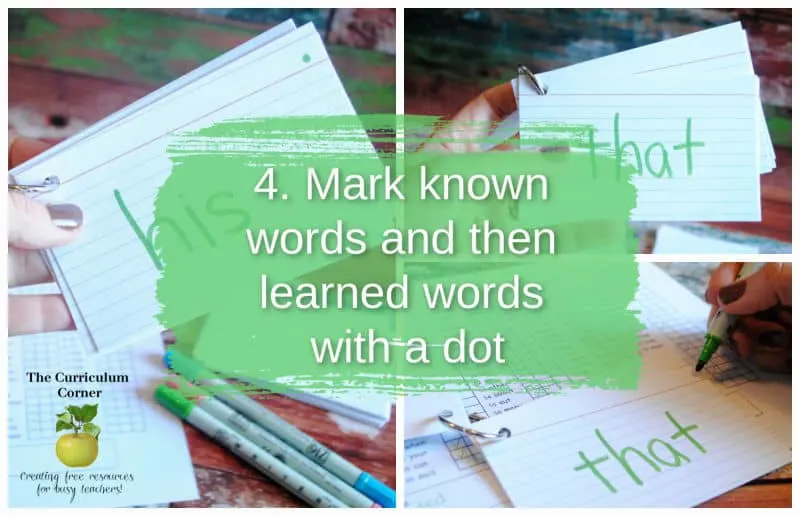
4. Mark known words and learned words with a dot
Next, it is time to practice! Sometimes students can work on reading their words independently (when fluency is the goal.) If students are working on learning new words, it is helpful to allow them to partner up. That way they have a student to help them with unknown words.
These Fry stacks can be practiced during morning work time or at a literacy center. Some students choose to practice their words during independent reading. If you are lucky enough to have an adult or older student helper, working with these Fry word stacks can be a good task.
When students show mastery of new words, add a dot to the top right corner. This will help you keep the balance of three to one as you add new words.
As students learn new words, I add cards from their unknown words to their stacks. I try to keep their stacks to no more than 20 words. I clean out old cards from time to time and send them home in a baggie. I tell students that these make great reading practice for home to work on fluency.
What if I am having difficulty finding enough known words?
Sometimes we have students that are just beginning to learn English or have had little experience with reading. For these students, it is even more important to follow the three to one rule.
If you can’t find enough known words to create a stack for a student, think simple. Include their name, maybe your name or a friend’s name. You can also include words with pictures.
Maybe draw an apple and write apple. Or, draw a ball and write ball. Another ideas is to use color words. You can use a red marker to write red, a blue marker to write blue.
Number words are another idea because you can write the number next to the word.
You’re on your way to building Fry or sight word mastery!
If you are wondering how to teach Fry word mastery, I hope you find this strategy helpful! I have been very excited by the success I have seen by implementing this simple approach. I have found that kids are very motivated to get new words added to their stack. They are excited to get new cards and work with their friends to learn new words. I have had many classes with students who begin as nonreaders and who are just learning English. This is my favorite strategy.
I know it’s one more assessment to add to your list but I found that the time spent getting it set up was worth my while. Do you have another strategy you have found useful for helping students master sight words? I would love to hear your ideas below.
If you are looking for assessment pieces, checklists, games and more to help you teach Fry words, go to Fry Resource Collection for free resources.

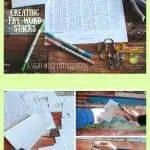
Beth Libby-Neale
Sunday 7th of February 2021
I found this very useful.
Dolch Sight Words - The Curriculum Corner 123
Friday 6th of March 2020
[…] who were just learning English benefited from this strategy. Take a look at our tutorial on Creating Fry Word Stacks to get […]
Charlbert Robinson
Tuesday 16th of May 2017
Thank you so much for your information on fry stacks. I can't wait to begin using this in the classroom!
Fry Word Tracking Check Off Pages - The Curriculum Corner 123
Friday 13th of January 2017
[…] Here you will find our video on how to make Fry Word Stacks […]
MARIA DIOCARETZ
Saturday 13th of February 2016
Thank you so much to share these material and ideas to teach English in Chile.
Brenda Henry
Monday 9th of January 2017
In our Language Arts program there are sight words introduced with "pre-decodable" books each Friday.. There are 15 of these. Then it goes on with 20 "decodable" books. I have a word wall that I post the sight words on that we introduce each week. In my district 60% of the students are English learners and approximately 91% of the student population is eligible for free and reduced-price meals. I teach Kindergarten. I begin week one with five color words. Then five more week two. By week three the sight words begin. Through out the year we end up with 100 words on the word wall. We read them everyday in the classroom. My team makes cardstock words for the students to take home to practice. Most years the students are very successful at reading the words. In my class, we also make three sentences orally each day using the words to help the students use the words in context and to understand that they should not just be word calling.